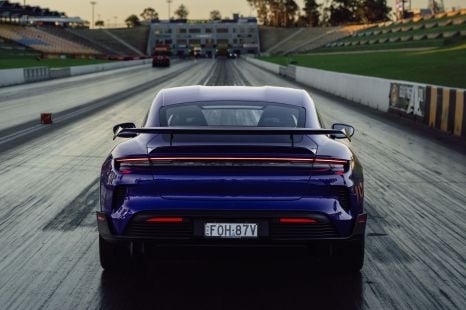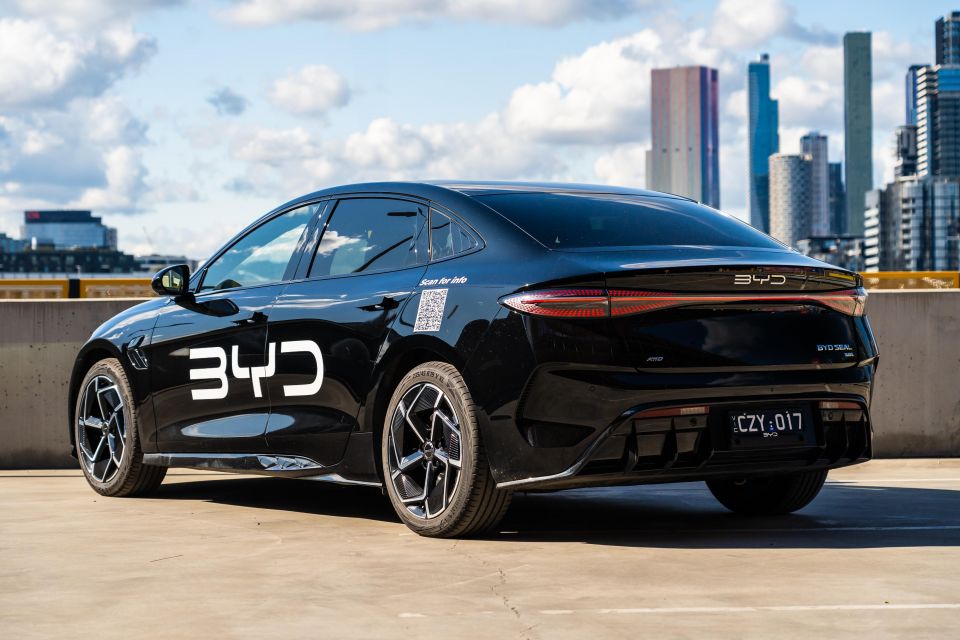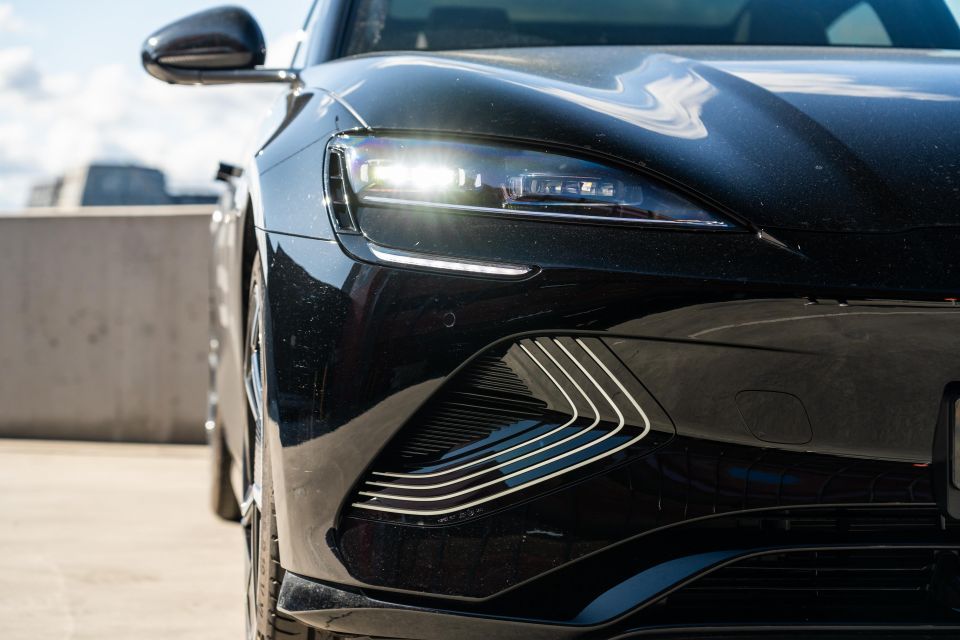

Toby Hagon
Banned! The car that’s too quick for Aussie drag strips
18 Hours Ago
Quickly see how this car stacks up against its competition. Select any benchmark to see more details.
Where expert car reviews meet expert car buying – CarExpert gives you trusted advice, personalised service and real savings on your next new car.
If I say the word ‘Seal’, you’ll probably think of the cute aquatic mammal or the rubber lining of your tailgate.

But it’s also the name of BYD’s answer to the popular Tesla Model 3 battery-electric mid-sized sedan. The BYD Seal has barely been on sale in Australia for a year, but in that time it has made quite the splash.
Despite local consumer tastes shifting towards SUVs and utes, the Seal has quickly become the Chinese brand’s most popular model in Australia… so far.
To the end of October 2024, BYD has registered 5621 examples of the Seal in Australia, which is more than its own Atto 3 (5256 units) and Sealion 6 (4229) SUVs. By comparison though, Tesla has registered 14,475 Model 3 sales in the same timeframe.
Still, the BYD outsells just about every other medium sedan in Australia bar the Toyota Camry, effectively outgunning the volume of the Honda Accord, Hyundai Sonata, Mazda 6 and Skoda Octavia combined.
WATCH: Paul’s video review of the BYD Seal Performance
So why has it proven so popular? Well, value is certainly one aspect, given the range starts at just under $50,000 before on-road costs, and the Performance flagship on test here can be had for under $70,000 plus on-roads, easily undercutting the equivalent Model 3.
It’s also, put simply, just a good car – find out why in this review.
The BYD Seal is priced from just $49,888 plus on-road costs, though the flagship Seal Performance AWD we’re testing here is priced from $68,748 before on-road costs.

| Model | Price before on-road costs |
|---|---|
| BYD Seal Dynamic | $49,888 |
| BYD Seal Premium | $58,798 |
| BYD Seal Performance AWD | $68,748 |
To see how the BYD Seal lines up against the competition, check out our comparison tool
Buy your new car without the stress. It's fast, simple and completely free.

Great service from Travis and team, second time I have used this business would not hesitate to recommend them to anyone
Craig C.
Purchased a Ford Ranger in Sunshine Coast, QLD
CarExpert helped Craig save $7,224 on his Ford Ranger, now let us save you on your next new car.
Get your BEST priceIf you’ve sat in or driven a BYD before, it’s more of the same from the Chinese brand’s stable, along with some unique touches to distinguish the Seal from other models in the range.

The displays all employ a familiar interface and, in a cool party trick, that massive 15.6-inch touchscreen can rotate between portrait and landscape orientations at the touch of a button.
Ahead of the driver is a freestanding 10.25-inch digital instrument cluster that offers a couple of different views and various menus. It’s also pretty clean and attractive in its presentation, which is a plus. The seats are also comfortable, with a sporty design and decent side bolstering, though the base cushion could use some extra side support.
Compared to the Tesla Model 3, a proper driver’s display as well as wireless Apple CarPlay and Android Auto connectivity might be key points that sway you if you’re into more conventional layouts.
The infotainment system itself is actually really good. Usually, I’m critical of the user interfaces employed by many Chinese brands as they’re often undercooked and under featured versions of the multimedia systems available in their domestic market, but BYD has done a great job of getting this system ready for the Australian market.




Beyond wireless smartphone mirroring, there’s standard FM/DAB radio, satellite navigation, access to embedded music streaming services, Bluetooth phone and audio streaming, and over-the-air software updates.
It’s clean, user-friendly and offers pretty snappy response. It’s also hooked up to a pretty good 12-speaker Dynaudio-branded audio system.
While there’s little in the way of physical switchgear beyond a shortcut pod of buttons around the shifter, access to the wider array of infotainment and climate control functions is all via the touchscreen.
If you need to change fan speed or temperature on the move it can get a little fiddly, but there are at least auto climate, fan on/off and front demister buttons on the centre console.
You also get dual wireless phone chargers ahead of the Volvo-like clear shift selector, and below the bridge-style centre console is a lower storage compartment that’s also home to USB-A and USB-C inputs, as well as a 12V socket.
So the first row is pretty good, and I found the perception of quality to be pretty high – plenty of soft-touch materials with nicely contrasting top-stitching elements and neat quilting motifs on the seat upholstery.


Those in the rear aren’t forgotten about either.
If you’re a little above average height like 6’1″ me, you’ll find there’s good space even behind a driver around your height.
Leg and knee room are good, though toe room is on the tighter side if the front seats are in their lowest positions. Head room is also decent, despite the standard fixed panoramic sunroof.
Amenities include rear air vents with a small storage slot at the rear of the centre console, a flip-down armrest with cupholders, ISOFIX and top-tether child seat anchor points, and dual map pockets on the backs of the front seats.

Under the bootlid, there’s a quoted 400 litres of luggage capacity, which while adequate is nearly 200 litres down on the claimed volume of the Model 3.
Further, there’s 50 litres in the ‘frunk’, which again is down on the Model 3’s quoted 88 litres.
| Dimensions | BYD Seal Performance AWD |
|---|---|
| Length | 4800mm |
| Width | 1875mm |
| Height | 1460mm |
| Wheelbase | 2920mm |
| Cargo capacity | 400 litres – rear 50 litres – front |
To see how the BYD Seal lines up against the competition, check out our comparison tool
The top-shelf Seal Performance is the sole variant available with a dual-motor AWD powertrain.

| Specifications | BYD Seal Performance AWD |
|---|---|
| Drivetrain | Dual-motor electric |
| Battery | 82.5kWh LFP |
| Power | 390kW |
| Torque | 670Nm |
| Driven wheels | All-wheel drive |
| Weight | 2185kg |
| 0-100km/h (claimed) | 3.8 seconds |
| Energy consumption (claimed) | N/A |
| Energy consumption (as tested) | 18.6kWh/100km |
| Claimed range | 520 kilometres – WLTP |
| Max AC charge rate | 7KW |
| Max DC charge rate | 150kW |
To see how the BYD Seal lines up against the competition, check out our comparison tool
This was my first ever drive in the BYD Seal, and I came away pretty impressed with the electric sedan.

For daily driving to and from work I quite enjoy the serenity and linearity of EV driving. The Seal is smooth, quiet and pretty comfortable.
Immediate torque delivery and the lack of combustion engine noise are no doubt factors in why an increasing amount of Australians are turning to electric vehicles and plug-in hybrids for the daily grind.
In its standard setting, the Seal is very much a sleeper, offering light controls and effortless response to give off more of a lazy, luxury vibe rather than overtly telling you it’s capable of accelerating at warp speed.
The steering is light, the suspension tune is on the softer side – particularly for something called ‘Performance’ – which makes this sedan easy to manoeuvre in heavy traffic and tight city streets.

It might make you question whether it’s worth spending the extra $10,000 for the Performance over the Premium with the Extended Range battery pack, given the Seal’s more comfort-leaning tuning.
Further, if the Seal’s primary role is to be an everyday commuter, the tradeoff in performance by going for the single-motor Premium with an extra 50km in claimed WLTP range (570km), while maintaining a respectable 5.9-second 0-100km/h acceleration claim.
But, if you prefer the added grip of all-wheel drive, as well as knowing you can scoot to the legal limit in less than 4.0 seconds, the Seal Performance is the pick for you.
I gave it a bootful a couple of times in Sport mode, and I can confirm the Seal Performance is bloody fast, probably faster than it needs to be. It just hooks up and goes, and it certainly feels as quick as its sub-4.0s claim suggests.

To be honest though, I would be more than happy with the mid-spec Premium and its extra range. The Performance, while very fast in a straight line, feels a little too subdued to be a proper sports sedan.
I’ve had far more engaging experiences in lower-powered combustion vehicles like the BMW 3 Series – 320i or 330i – and while even this flagship Seal is, remarkably, still cheaper than even the cheapest 3 Series, if you want a proper sports sedan experience you may be better served elsewhere.
Still, the accurate steering makes the Seal a nice thing to steer, though the softer suspension means you can feel the Seal’s weight in bends. Plant your foot out of an apex and you get some wheel scrabble as well.
Think of it more of a very fast GT.

From a driver assistance tech perspective, BYD is definitely at the front of the Chinese pack for calibration, with systems that are much closer to segment benchmarks.
Adaptive cruise control and lane centring are pretty good, though at times the adaptive cruise was a touch conservative and indecisive with lead vehicles that teeter between speeds.
Blind-spot monitoring and rear cross-traffic alert also come in handy, and the excellent surround camera vision means there’s no excuse for rashed wheels or scraped bumpers.
To see how the BYD Seal lines up against the competition, check out our comparison tool
The Performance sits atop a three-variant lineup in Australia.




Seal Dynamic highlights:
Seal Premium adds:
Seal Performance AWD adds:
To see how the BYD Seal lines up against the competition, check out our comparison tool
The BYD Seal has a five-star ANCAP safety rating based on Euro NCAP testing in 2023.

Where expert car reviews meet expert car buying – CarExpert gives you trusted advice, personalised service and real savings on your next new car.
| Category | MAKE MODEL |
|---|---|
| Adult occupant protection | 89 per cent |
| Child occupant protection | 87 per cent |
| Vulnerable road user protection | 82 per cent |
| Safety assist | 75 per cent |
Standard safety equipment includes:
To see how the BYD Seal lines up against the competition, check out our comparison tool
The BYD Seal is backed by a six-year, 150,000km vehicle warranty and an eight-year, 160,000km battery warranty.

| Running costs | BYD Seal Performance AWD |
|---|---|
| Warranty | 6 years or 150,000 kilometres – vehicle 8 years or 160,000 kilometres – EV battery |
| Roadside assistance | 12 months |
| Service intervals | 12 months or 20,000 kilometres |
| Capped-price servicing | Up to 11 years |
| Total capped-price service cost | $2016 – 5 years |
To see how the BYD Seal lines up against the competition, check out our comparison tool
Buy your new car without the stress. It's fast, simple and completely free.

Great service from Travis and team, second time I have used this business would not hesitate to recommend them to anyone
Craig C.
Purchased a Ford Ranger in Sunshine Coast, QLD
CarExpert helped Craig save $7,224 on his Ford Ranger, now let us save you on your next new car.
Get your BEST priceFunny name aside, the BYD Seal really is no joke.

It’s an objectively good product with very sharp pricing and a great deal of standard equipment. For those wanting a more like-for-like alternative to the Tesla Model 3, it hits the mark in most area and significantly undercuts its US-engineered, Chinese-made rival.
Beyond that, it’s an excellent commuter, with punchy performance and good range. The cabin offers a smart design and it’s ergonomically more conventional than something like a Model 3, while also still daring to be a little different.
Rear seat and boot space are adequate without being excellent; and while there’s good driving range on offer regardless of the variant you choose, indicated efficiency of over 18kWh/100km isn’t remarkable, nor is the DC charging capacity of 150kW.
As for whether the Performance is the pick, I think my gripes with this car could easily be addressed by going for one of the more affordable grades.

The softer, more comfort-oriented ride and handling calibration would better suit either the entry-level or mid-spec grades, with the latter offering superior driving range at a $10,000-lower price point.
I also think that while the cabin is relatively nicely trimmed, some of the cheaper interior surfaces and finishes are far more acceptable in a $58,000 BYD Seal than a $68,000 one.
At the Performance’s price point – performance aside – you’re also looking at some pretty strong competition beyond the Model 3. The more distinctive Hyundai Ioniq 6 starts from $66,500, while the Polestar 2 Long Range Single Motor offers an impressive 659km of WLTP range for a starting of $66,400 (both prices exclude on-road costs).
Still, the BYD Seal has a lot to offer, and is more than worthy of your consideration if you’re in the market for an electric sedan.

Interested in buying a BYD Seal? Get in touch with one of CarExpert’s trusted dealers here
Click the images for the full gallery
MORE: Everything BYD Seal
Where expert car reviews meet expert car buying – CarExpert gives you trusted advice, personalised service and real savings on your next new car.
James Wong is an automotive journalist and former PR consultant, recognised among Australia’s most prolific motoring writers.


Toby Hagon
18 Hours Ago


Andrew Maclean
2 Days Ago


William Stopford
9 Days Ago


CarExpert.com.au
10 Days Ago


James Wong
11 Days Ago


Damion Smy
11 Days Ago